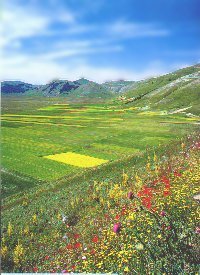 |
| Piano Grande |
But this tale-ridden land that has fascinated writers and painters for many centuries is also a precious and uncontaminated natural reserve that attracts visitors from all over the world.
The Parco Nazionale dei Monti Sibillini comprises over 50 mountain peaks over 2,000 metres high, that rise at the heart of the park area, stretching for no less than 40 kilometres from north to south between Umbria and the Marches. The highest of these peaks is Monte Vettore (2,476 metres), followed by Monte Priora, Monte Bove, Monte Sibilla</b and a number of others
A massive limestone block, the Monti Sibillini were deeply hewn by glaciers in the quaternary period. The traces of these glaciers are still clearly visible today in the glacier circles of Monte Vettore, Monte Bove, the upper Valle dell’Ambro and Val di Tela.
Carsism is another factor that had a strong influence on the morphology of the Monti Sibillini. This is particularly evident in the Piani di Castelluccio, but also in the numerous dolines at Palazzo Borghese, in the upper Val di Panico and in the Ambro valley.
Although greater in extension, the Marches side of the park is also the wildest. The Umbrian side of the park includes the western flank of the Monte Vettore and is considerably tamed by the Piano Grande and the Piano Piccolo.
Along with the less smaller Piano Perduto (called thus because it was lost by Norcia in a border squabble with Visso) and Piano dei Pantani, the Piani (or planes) in the past made up the bottom of a lake. The waters of this lake drained through a vast crack near the Mergani carsic incision in the Piano Grande. This crack still drains water today, but where the water goes to remains a mystery.
The Piano Grande is a particularly popular tourist destination during the spring flowering season, generally at the end of June and known as Fiorita. This area is also home to two endemic botanical plant species: Carex buxbaumii and Carex disticha.
From the western crest of Monte Vettore to the peak of Monte Porche grow Alpine Stars of the Apennines and the Apennine Genepě.
Wildlife in the park includes the Apennine wolf, the wild cat, the porcupine, the roebuck and the ever-rarer marten. Birds of prey present in the park include the golden eagle, the goshawk, the sparrow hawk, the peregrine falcon and even the great owl. Other bird varieties supported by the park include the rock partridge, the Alpine chough and the coralline chough. Birdwatchers will be interested to spot the Arctic plover and the redstart, as well as the Alpine accentor, the Alpine chaffinch and the woodpecker.
But the park's most interesting species are to be found among the invertebrates:
coleoptera Duvalius ruffoi (typical of Monte Vettore) and Chrysocloa sibilla; crustaceans Chirocephalus marchesonii, which lives only in the Pilato lake, Chirocephalus sibyllae, which in turn lives only in a small nearby lake, and Paraleptophlebia ruffoli, which lives only in a small lake of the Piano Piccolo.
But the wonders of this park can be admired in all seasons, be it walking and trekking in the summer or cross-country skiing in the winter.








